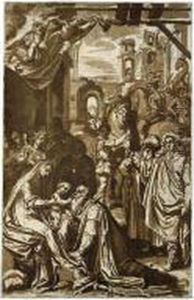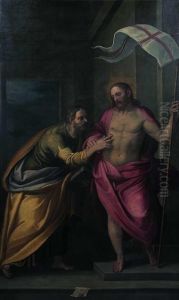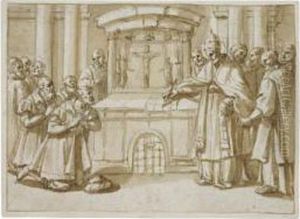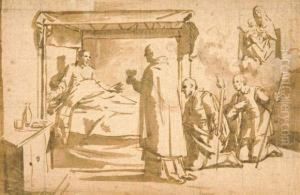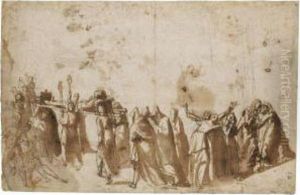Giovanni Battista Ricci Paintings
Giovanni Battista Ricci was an Italian painter of the late Renaissance period, born in 1537 in Novara, Duchy of Milan (now in the Piedmont region of Italy). He is often confused with another Italian artist with a similar name, Giovanni Battista Ricci, known as Il Novara, who was also active around the same period. However, the latter was primarily an architect and engineer. Giovanni Battista Ricci, the painter, is known for his work in the Mannerist style, which was characterized by artificiality, grace, and elegance that often took precedence over the naturalistic representation seen in the earlier High Renaissance.
Ricci's artistic journey began with his training, which is not fully documented, but it is believed that he might have been influenced by the work of Bernardino Campi and Giulio Cesare Procaccini, both of whom were active in the Milan area. Ricci's works often incorporated a strong use of color and a preference for complex, dynamic compositions. He was particularly adept at fresco painting, and much of his work adorned the walls of churches and palaces.
In 1585, Ricci moved to Rome, where he became part of the vibrant artistic community and was exposed to the works of Raphael and Michelangelo, whose influence can be seen in his own frescoes. In Rome, Ricci worked for several important patrons, including Pope Sixtus V. He was involved in the decoration of the Vatican Belvedere and executed frescoes in the Scala Santa at the Lateran, which were sadly destroyed later. His work was also part of the extensive decorations carried out in the Quirinal Palace under the direction of the architect Ottaviano Mascherino.
Giovanni Battista Ricci's religious works are characterized by their vivid depiction of biblical scenes. He painted altarpieces and narrative cycles, which were distinguished by their refined color schemes and the emotional intensity of the figures. Despite his achievements, Ricci's work was eventually overshadowed by the rising Baroque style, which gained prominence in the 17th century with artists such as Caravaggio and the Carracci brothers leading the way.
Ricci continued to work into his later years, and his style evolved, showing some adaptation to the changing tastes of the period. He passed away in 1627, leaving behind a body of work that, while not as well-known today, contributed to the rich tapestry of Italian Renaissance art. His legacy is preserved in the frescoes and paintings that survive, offering insight into the transition of styles from the Mannerist to the early Baroque period.
